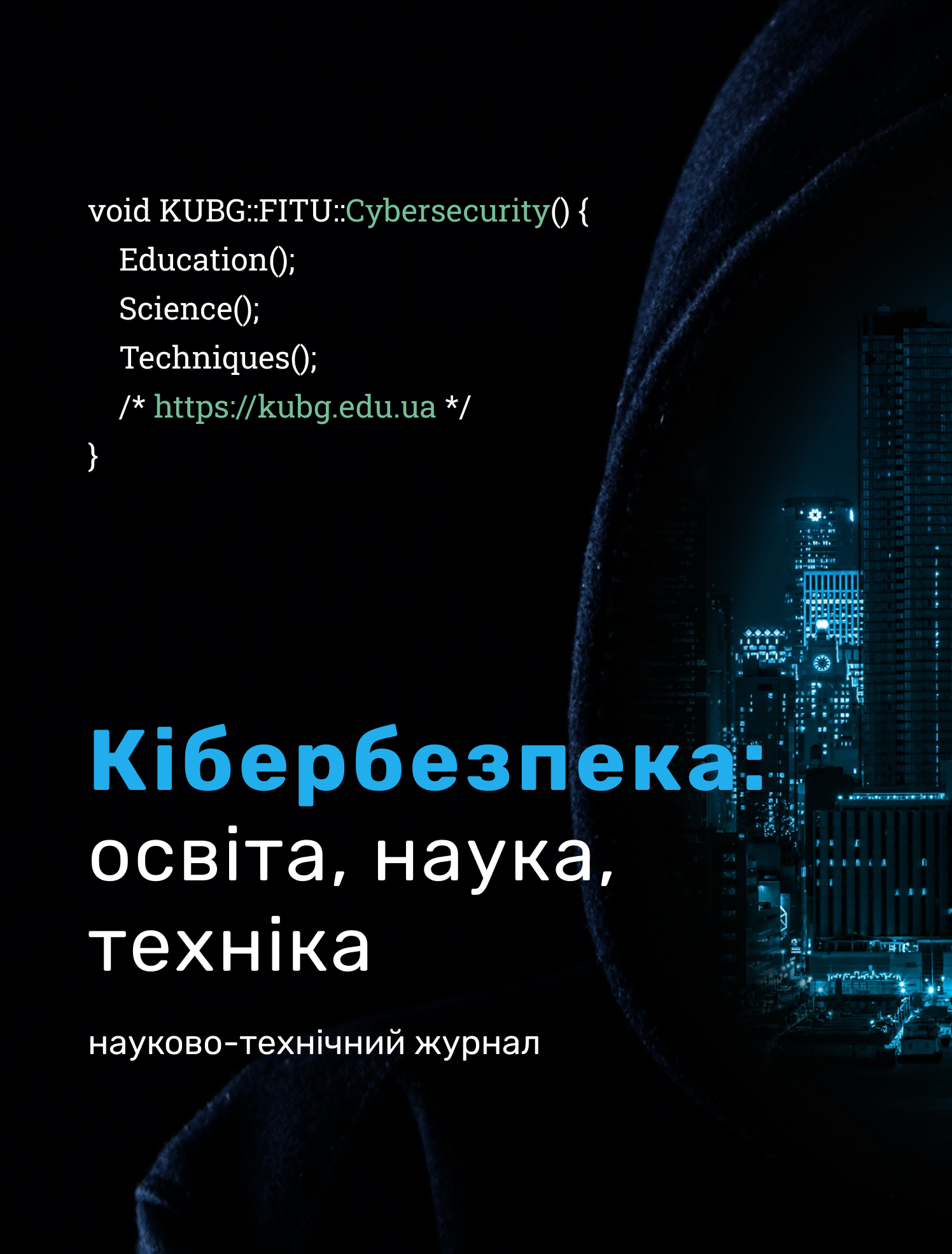MODELS AND TECHNOLOGIES OF INTELLIGENT PROTECTION OF INFORMATION SYSTEMS OF CRITICAL INFRASTRUCTURE FOR ENHANCING RESILIENCE
DOI:
https://doi.org/10.28925/2663-4023.2025.29.948Keywords:
critical infrastructure, information systems, cybersecurity, resilient functioning, crisis (situational) centers, scenario modeling, artificial intelligence, intelligent agents, decision support systems.Abstract
The article substantiates the feasibility of using modern information technologies to ensure the sustainable functioning of critical infrastructure (CI) facilities, with a focus on protecting their information systems, which are a key factor in national security and the resilience of the state against hybrid threats. It is demonstrated that enhancing the protection and recoverability of CI systems is possible through the establishment of an extensive network of crisis centers integrated with platforms for monitoring, detection, and real-time response to cyber incidents. Particular attention is paid to scenario modeling, which enables forecasting possible developments of cyberattacks, designing security management models, and supporting the decision-making process. This approach makes it possible to identify likely channels of impact on systems in advance, assess the consequences of their disruption, and generate optimal strategies for threat neutralization. An architecture of a multi-level system for managing the protection and recovery of CI information systems is proposed, taking into account both physical and cyber risks. It is based on the integration of intelligent technologies capable of providing adaptive responses to environmental changes and automated support for backup and recovery procedures. The feasibility of applying artificial intelligence in crisis centers is substantiated, particularly through agent-based systems that enhance the efficiency of analyzing large datasets, detecting anomalies in traffic, assessing risks, and generating managerial recommendations. The use of intelligent agents ensures speed and accuracy in the localization of cyber threats, significantly increasing the resilience of critical infrastructure information systems and forming the foundation for proactive cybersecurity mechanisms.
Downloads
References
Rehman, A., Awan, K.A., Al-Rasheed, A., Ara, A., Alruwaili, F., Alotaibi, S., & Saba, T. (2025). A novel hybrid fuzzy logic and federated learning framework for enhancing cybersecurity and fraud detection in IoT-enabled metaverse transactions. Egyptian Informatics Journal, 30, 100668. https://doi.org/10.1016/j.eij.2025.100668
Zybin, S., Korchenko, O., Korystin, O., Shulha, V., Kazmirchuk, S., & Demediuk, S. (2025). Method for the risk assessing of hybrid threats in cyber security based on fuzzy set theory. SSRN Preprint. https://ssrn.com/abstract=5143937 or http://dx.doi.org/10.2139/ssrn.5143937
Kim, C., So-In, C., Kongsorot, Y., et al. (2024). FLSec-RPL: a fuzzy logic-based intrusion detection scheme for securing RPL-based IoT networks against DIO neighbor suppression attacks. Cybersecurity, 7, 27. https://doi.org/10.1186/s42400-024-00223-x
Kshetri, N. (2025). Transforming cybersecurity with agentic AI to combat emerging cyber threats. Telecommunications Policy, 49, 102976. https://doi.org/10.1016/j.telpol.2025.102976
Karakaya, A. (2025). A hybrid approach for IoT security: combining ensemble learning with fuzzy logic. Sensors (Basel, Switzerland), 25(18), 5668. https://doi.org/10.3390/s25185668
Mayoral-Vilches, V., Navarrete-Lozano, L.J., Sanz-Gómez, M., Espejo, L.S., Crespo-Álvarez, M., Oca-Gonzalez, F., et al. (2025). CAI: An open, bug bounty-ready cybersecurity AI. arXiv preprint. arXiv:2504.06017
Havrys, A., Filippova, V., & Tur, N. (2024). Information analysis of protection systems of critical infrastructure facilities during martial law. Bulletin of the Lviv State University of Life Safety, 30, 173–187. https://doi.org/10.32447/20784643.30.2024.17
Hrechaninov, V.F. (2021). Features of decision support in governmental situational centers aimed at protecting critical infrastructure. Registration, Storage and Processing of Data, 23(3), 80–90. URL: http://jnas.nbuv.gov.ua/article/UJRN-0001304909
Kostiuk, Y., Skladannyi, P., Samoilenko, Y., Khorolska, K., Bebeshko, B., & Sokolov, V. (2025). A system for assessing the interdependencies of information system agents in information security risk management using cognitive maps. In Cyber Hygiene & Conflict Management in Global Information Networks (Vol. 3925, pp. 249–264).
Morozov, A.O., & Hrechaninov, V.F. (2025). Evolutionary development and the future of situational management technologies. Mathematical Machines and Systems, 1, 3–11. URL: http://www.immsp.kiev.ua/publications/articles/2025/2025_1/01_25_Morozov.pdf
Kostiuk, Yu. V., Skladannyi, P. M., Hulak, H. M., Bebeshko, B. T., Khorolska, K. V., & Rzaieva, S. L. (2025). Information security systems. [Textbook] Kyiv: Borys Grinchenko Kyiv Metropolitan University.
Hulak, H. M., Zhyltsov, O. B., Kyrychok, R. V., Korshun, N. V., & Skladannyi, P. M. (2023). Enterprise information and cyber security. [Textbook] Kyiv: Borys Grinchenko Kyiv Metropolitan University.
Kostiuk Y., Skladannyi P., Sokolov V., Hulak H., Korshun N. (2025). Models and algorithms for analyzing information risks during the security audit of personal data information system. In Proceedings of the Third International Conference on Cyber Hygiene & Conflict Management in Global Information Networks (CH&CMiGIN’24) (Vol. 3925, pp. 155–171).
Kostiuk Y., Skladannyi P., Sokolov V., Zhyltsov O., Ivanichenko Y. (2025). Effectiveness of information security control using audit logs. In Proceedings of the Workshop on Cybersecurity Providing in Information and Telecommunication Systems (CPITS 2025), 524–538.
Abramov, V., Astafieva, M., Boiko, M., Bodnenko, D., Bushma, A., Vember, V., Hlushak, O., Zhyltsov, O., Ilich, L., Kobets, N., Kovaliuk, T., Kuchakovska, H., Lytvyn, O., Lytvyn, P., Mashkina, I., Morze, N., Nosenko, T., Proshkin, V., Radchenko, S., Yaskevych, V. (2021). Theoretical and practical aspects of the use of mathematical methods and information technology in education and science. https://doi.org/10.28925/9720213284km
Kostiuk, Yu. V., Skladannyi, P. M., Bebeshko, B. T., Khorolska, K. V., Rzaieva, S. L., & Vorokhob, M. V. (2025). Information and communication systems security. [Textbook] Kyiv: Borys Grinchenko Kyiv Metropolitan University.
Published
How to Cite
Issue
Section
License
Copyright (c) 2025 Віктор Гречанінов

This work is licensed under a Creative Commons Attribution-NonCommercial-ShareAlike 4.0 International License.




